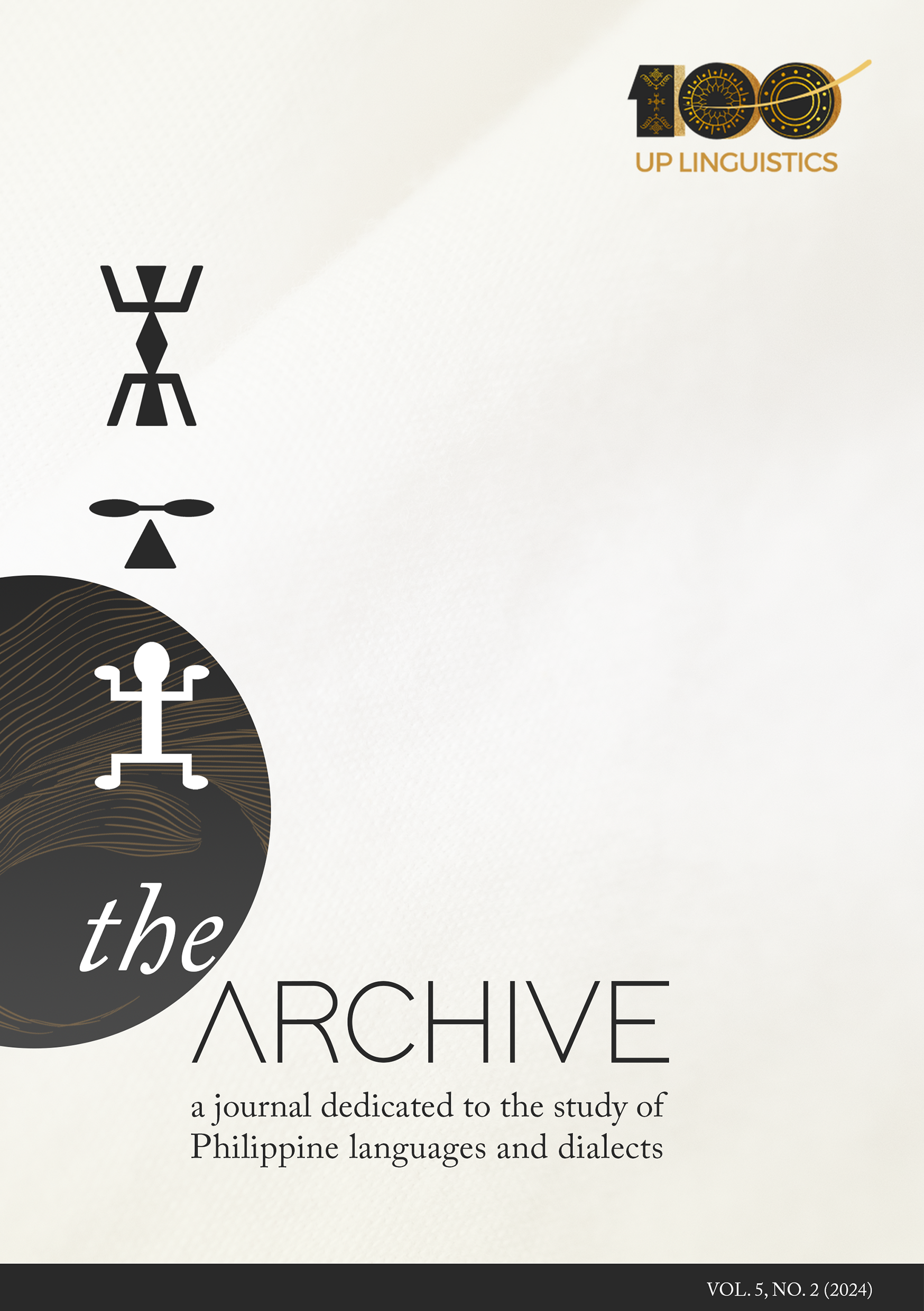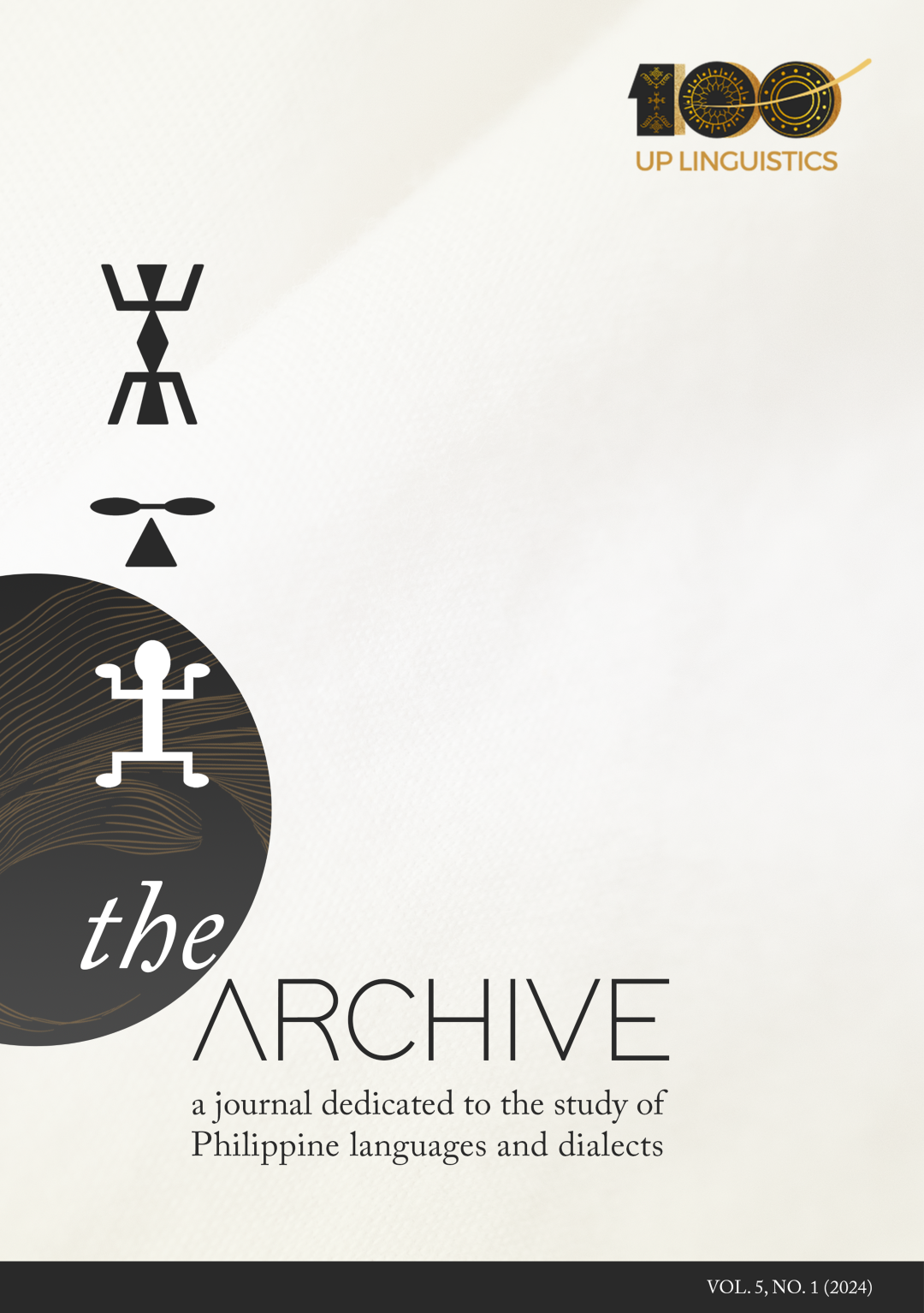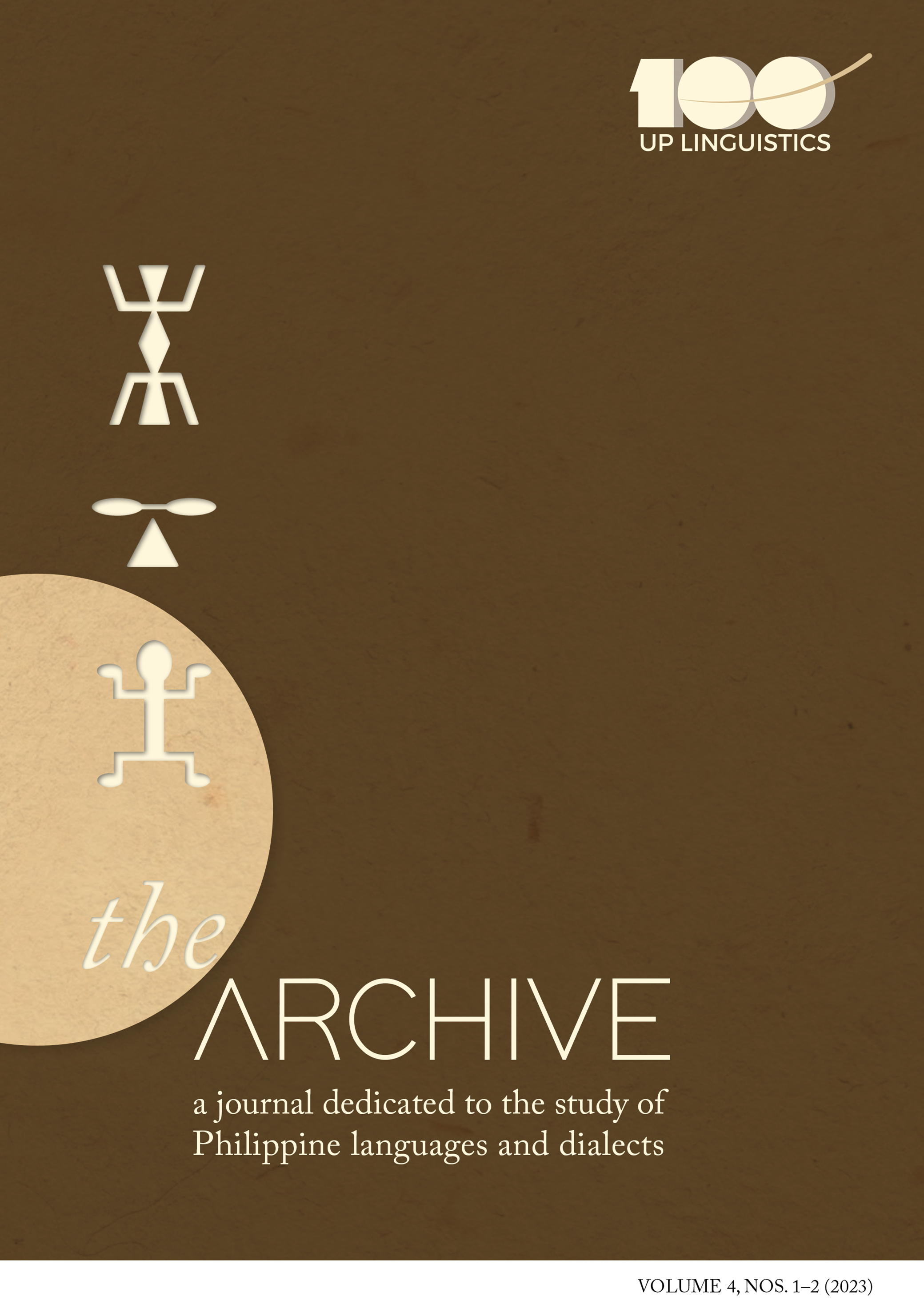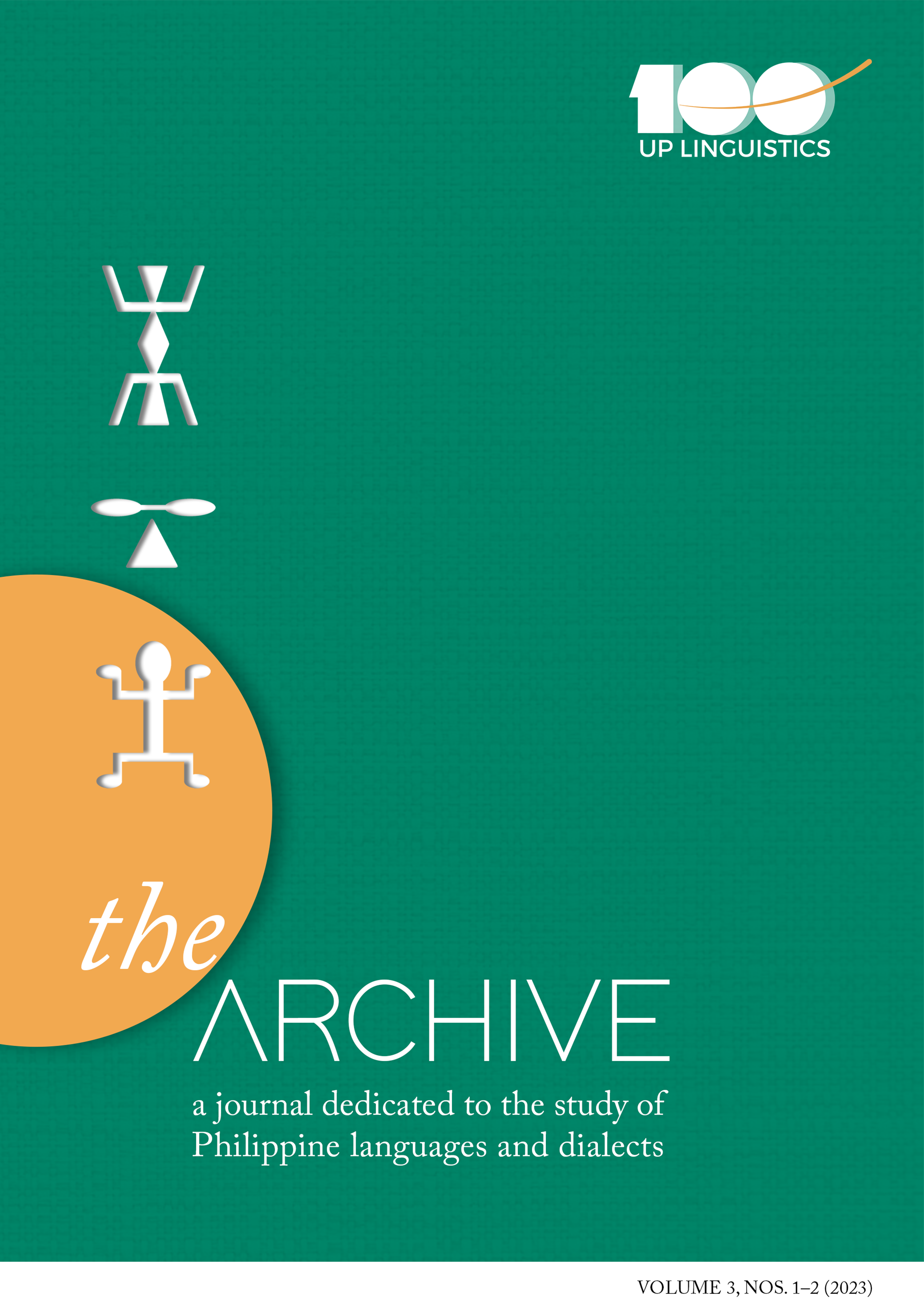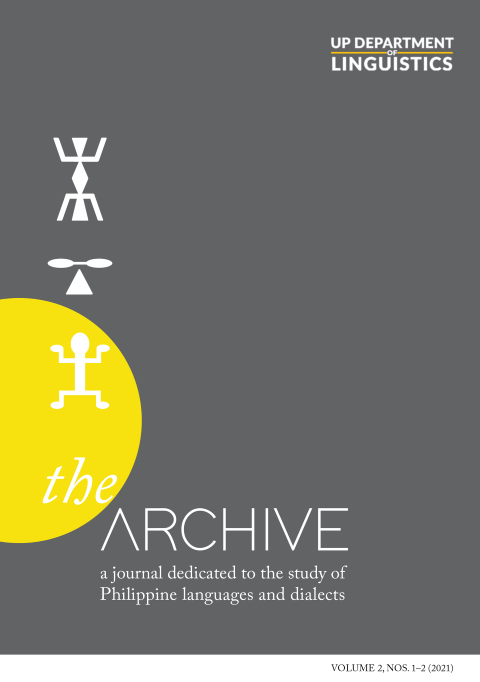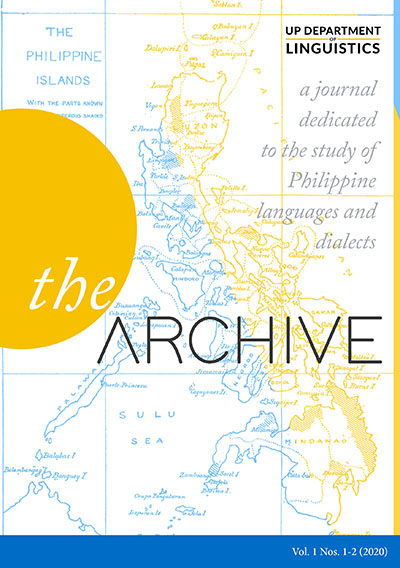-
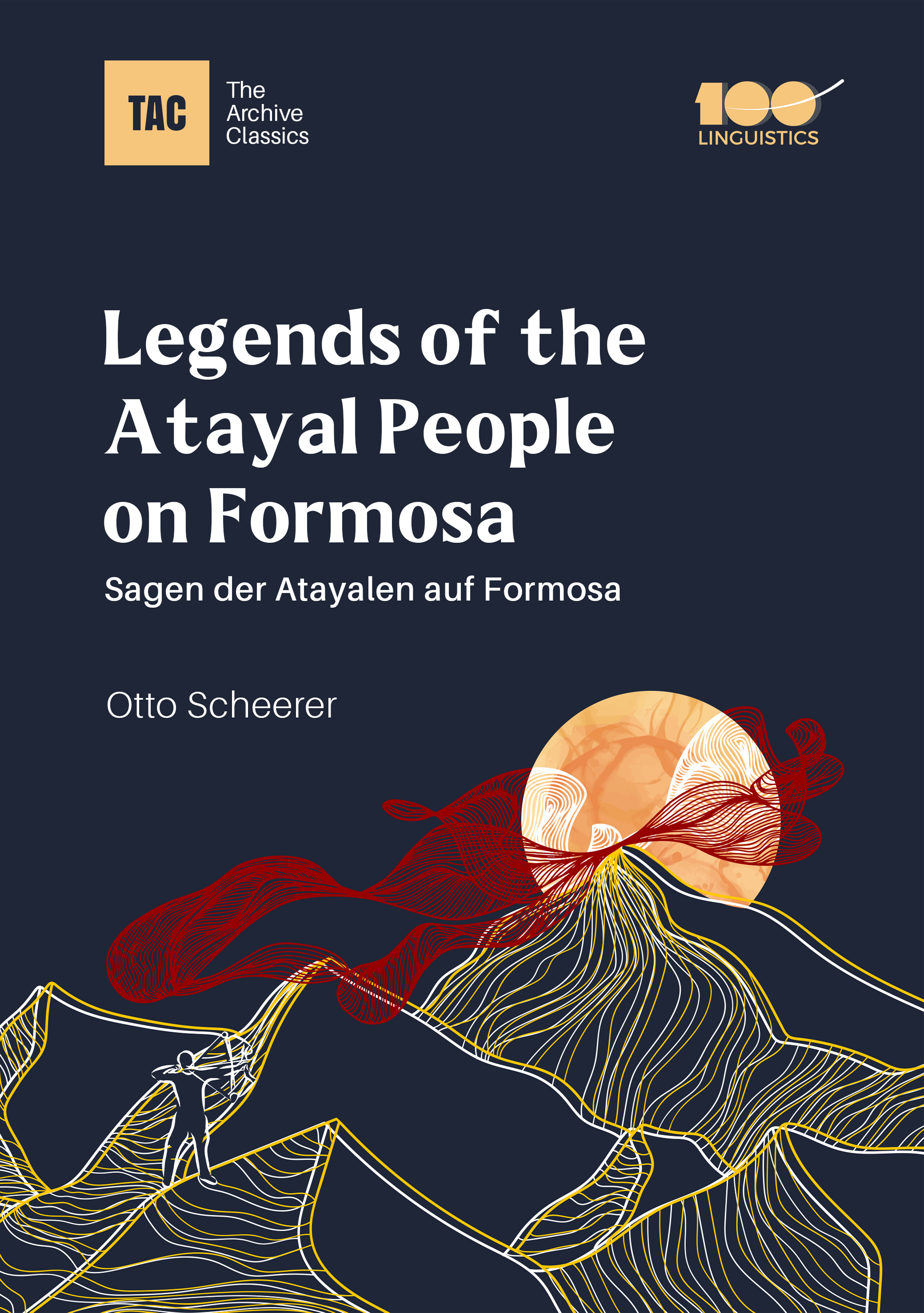 The Archive Classics: Legends of the Atayal People on Formosa
Vol 0 No 0 (2023)
The Archive Classics: Legends of the Atayal People on Formosa
Vol 0 No 0 (2023)This issue of The Archive Classics features a bilingual edition of Otto Johns Scheerer’s paper titled “Sagen der Atayalen auf Formosa” [Legends of the Atayal people on Formosa], originally published by Dietrich Reimer Hamburg Boysen in its 1932 issue of Zeitschrift für Eingeborenen-Sprachen.
-
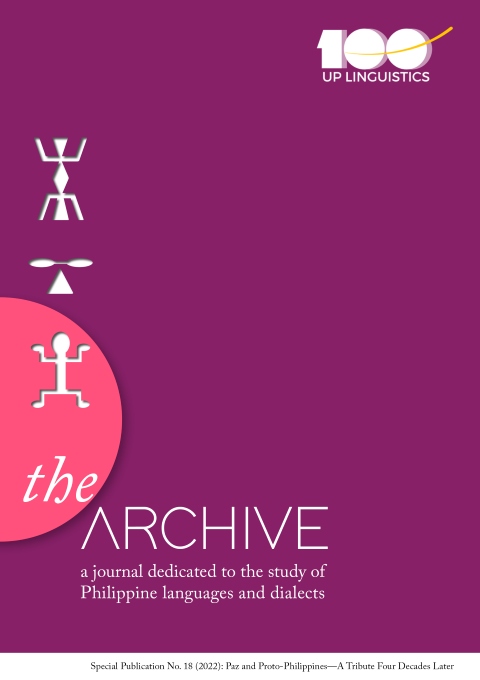 Special Publication No. 18: Paz and Proto-Philippines—A Tribute Four Decades Later
Vol 18 (2022)
Special Publication No. 18: Paz and Proto-Philippines—A Tribute Four Decades Later
Vol 18 (2022)This Special Publication is dedicated to Consuelo J. Paz (1933–2022), a linguist whose works not only contributed to establishing a stronger foundation for Philippine linguistics but also became instrumental in the advancement of Filipino as the National Language of the country.
-
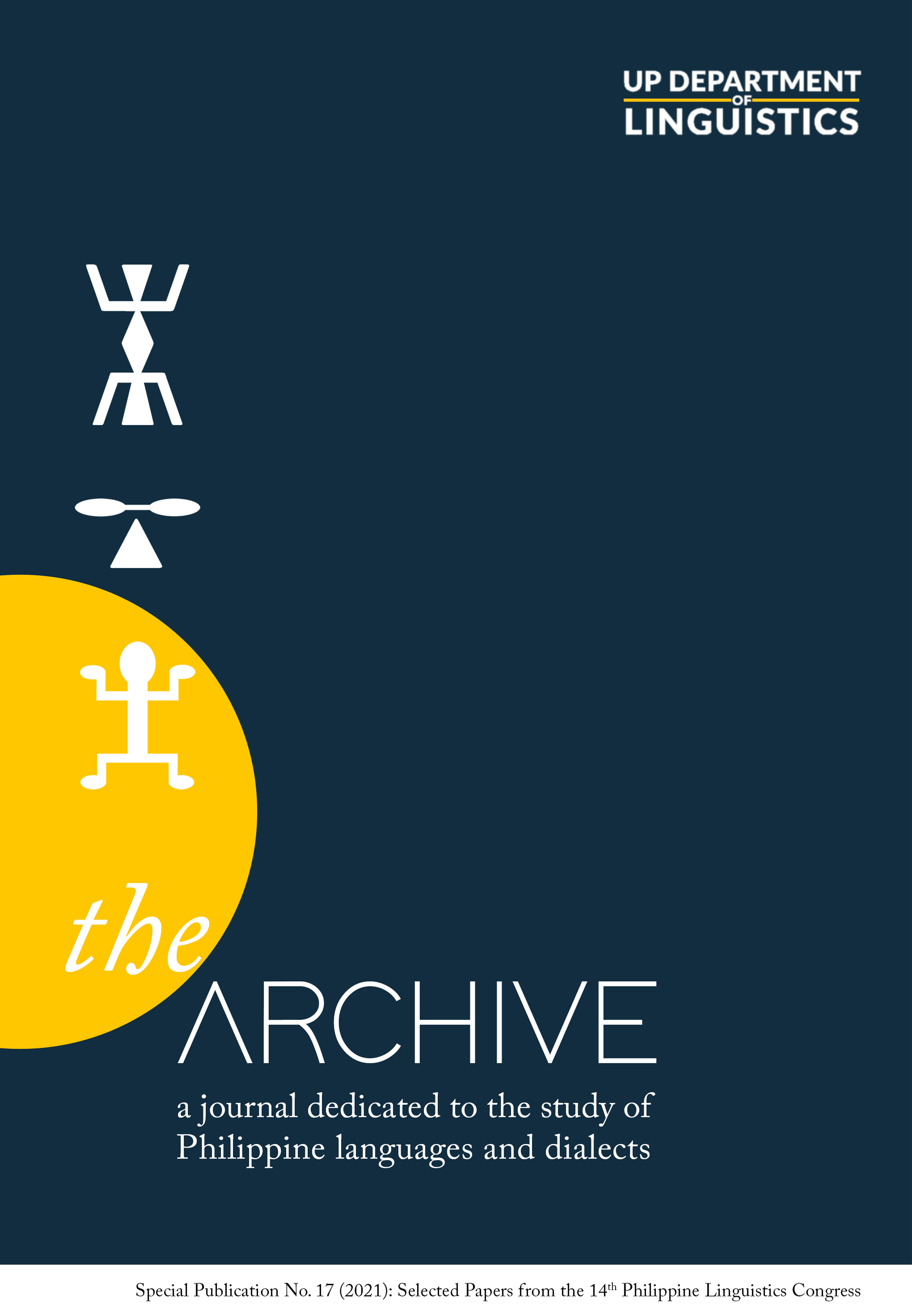 Special Publication No. 17: Selected Papers from the 14th Philippine Linguistics Congress
Vol 17 (2021)
Special Publication No. 17: Selected Papers from the 14th Philippine Linguistics Congress
Vol 17 (2021)This Special Publication features two papers presented during the 14th installment of the Philippine Linguistics Congress (14PLC), held by the Department of Linguistics at the University of the Philippines Diliman on 24–27 August 2021.
-
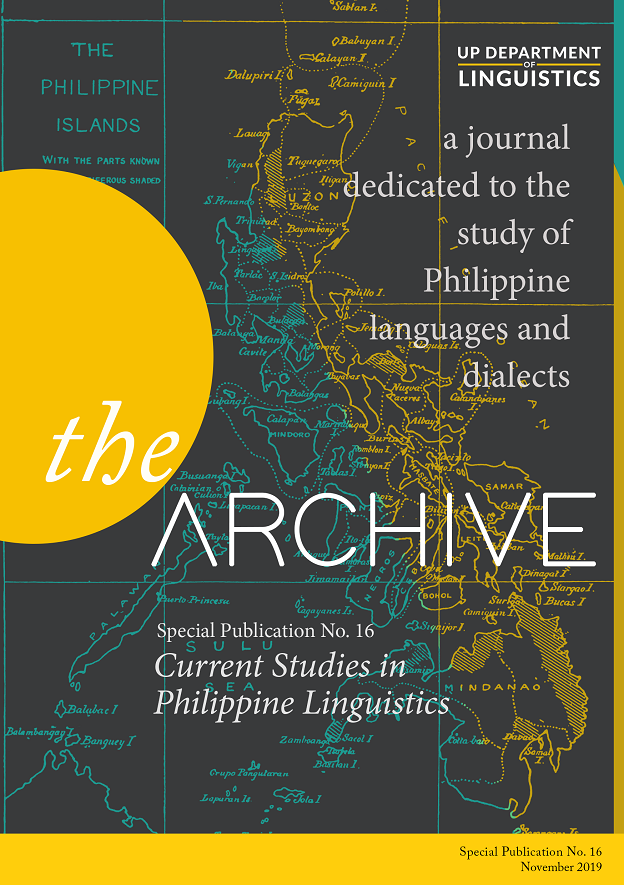 Special Publication No. 16: Current Studies in Philippine Linguistics
Vol 16 (2019)
Special Publication No. 16: Current Studies in Philippine Linguistics
Vol 16 (2019)This Special Publication of the journal compiles papers from esteemed scholars who have devoted much of their time in studying Philippine languages and linguistics.
-
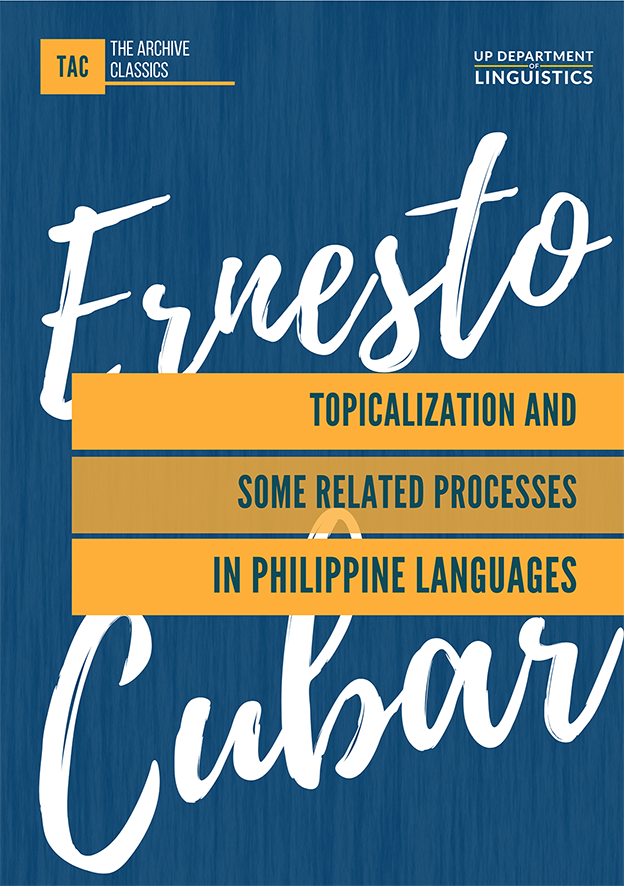 The Archive Classics: Topicalization and Some Related Processes in Philippine Languages
Vol 0 No 0 (2019)
The Archive Classics: Topicalization and Some Related Processes in Philippine Languages
Vol 0 No 0 (2019)The Archive Classics series reprints monumental works in Philippine linguistics that paved the way for further research in the field, and continue to influence current studies on Philippine languages.
Topicalization and Some Related Processes in Philippine Languages by Ernesto H. Cubar was originally published in 1975 as a monograph and was produced with the support of the University of the Philippines Social Sciences and Humanities Research Committee's (now the Office of the Vice-Chancellor for Research and Development under the University of the Philippines Diliman) endowment of Research Allotment No. 26, FY 1973-1974.
-
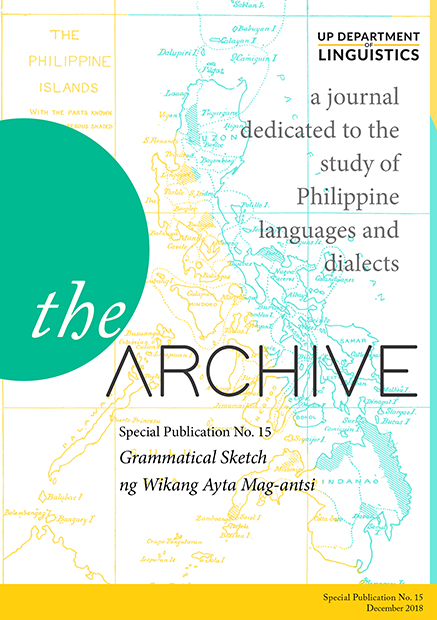 Espesyal na Publikasyon Blg. 15: Grammatical Sketch ng Wikang Ayta Mag-antsi
Vol 15 (2018)
Espesyal na Publikasyon Blg. 15: Grammatical Sketch ng Wikang Ayta Mag-antsi
Vol 15 (2018)Deskripsyon ng ponolohiya, morpolohiya, at istruktura ng mga pangungusap sa Wikang Ayta Mag-antsi
Patnugot ng Isyu
Viveca V. Hernandez
Mga May-akda
Sherma E. Beñosa
Jay-Ar M. Igno
Divine Angeli P. Endriga
Jem R. Javier
Sergei Klimenko
April J. Perez
Francisco C. Rosario, Jr.
Maria Paz C. San Juan -
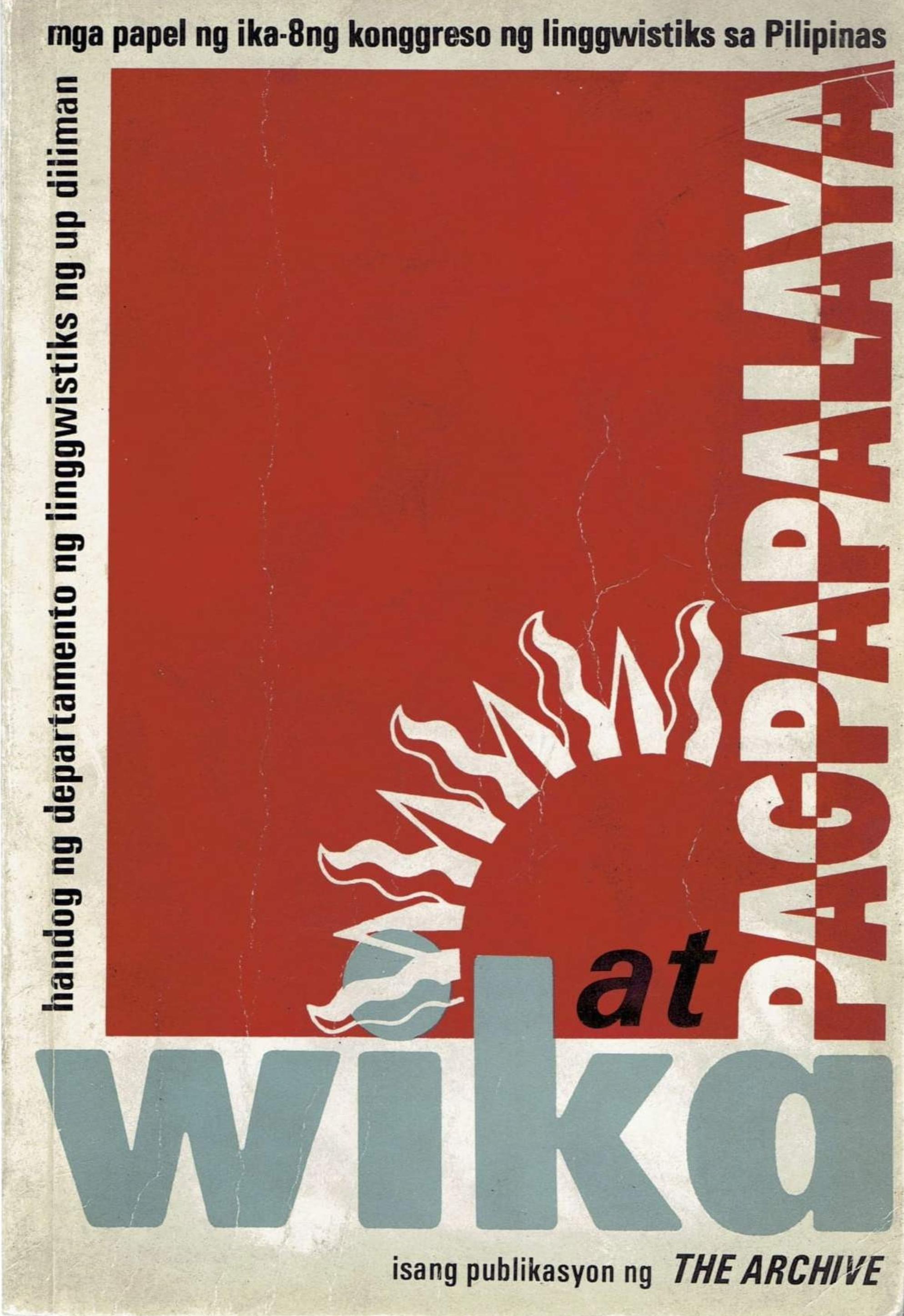 Publication Fourteen: Wika at Pagpapalaya
Vol 14 (1998)
Publication Fourteen: Wika at Pagpapalaya
Vol 14 (1998)This volume is a collection of papers presented at the 8th Philippine Linguistics Congress, held at the University of the Philippines Diliman from December 15–17, 1997. Showcasing the most pressing and significant language issues in the country at the time, the collection reflects a diversity of perspectives from linguists, language educators, historians, anthropologists, philosophers, sociologists, writers, and media practitioners. The interdisciplinary nature of these discussions highlights the complexity of linguistic issues in the Philippines and the necessity of collaboration across fields. Through these papers, the volume offers a multifaceted understanding of language as a crucial tool for social and national liberation.
-
 Publication Eleven: Three Studies on Philippine Morphology
Vol 11 (1996)
Publication Eleven: Three Studies on Philippine Morphology
Vol 11 (1996)This volume presents in-depth linguistic analyses of some Philippine languages—namely, Tagalog and South Sorsogon—focusing on morphology, syntax, and verb structures. Consuelo J. Paz provides a comprehensive study of Tagalog nouns and adjectives, detailing their morphological forms, syntactic functions, and phonological variations. Remedios M. Cayari examines Tagalog time adverbs, classifying them based on their structural forms—words, phrases, or clauses—and their grammatical functions. Antonio H. Escalante explores the verbal system of South Sorsogon, analyzing its verb morphology, inflectional patterns, and grammatical distinctions. Collectively, these studies contribute to a deeper understanding of Philippine linguistic structures, shedding light on their complexity and regional variations.
-
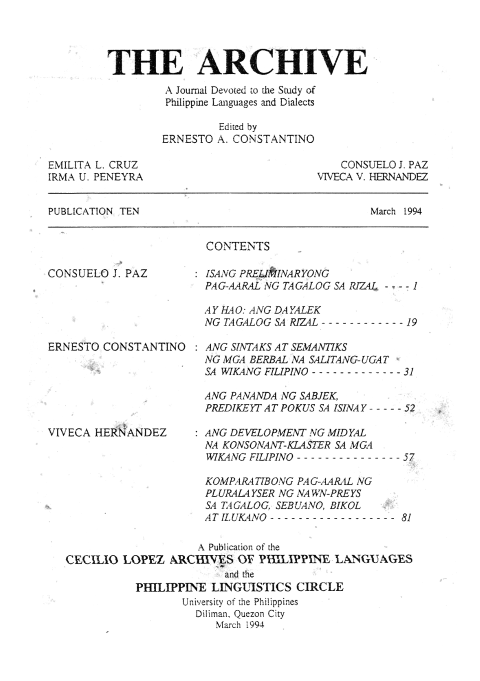 Publication Ten
Vol 10 (1994)
Publication Ten
Vol 10 (1994)This volume presents a collection of six linguistic studies focusing on Philippine languages done by pioneer Filipino linguists. Consuelo J. Paz examines the dialectal landscape of Rizal, aiming to identify distinct dialects and create a dialect atlas and further analyzes phonological variations within the region. Ernesto A. Constantino explores syntactic and semantic aspects of verbal root words in Filipino and investigates subject, predicate, and focus markers in the Isinay language. Viveca V. Hernández contributes two comparative studies: one on the development of medial consonant clusters in Philippine languages and another on pluralization processes in Tagalog, Cebuano, Bikol, and Ilocano. Together, these studies offer valuable insights into the phonological, morphological, and syntactic structures of Philippine languages, enhancing our understanding of their development and classification.
-
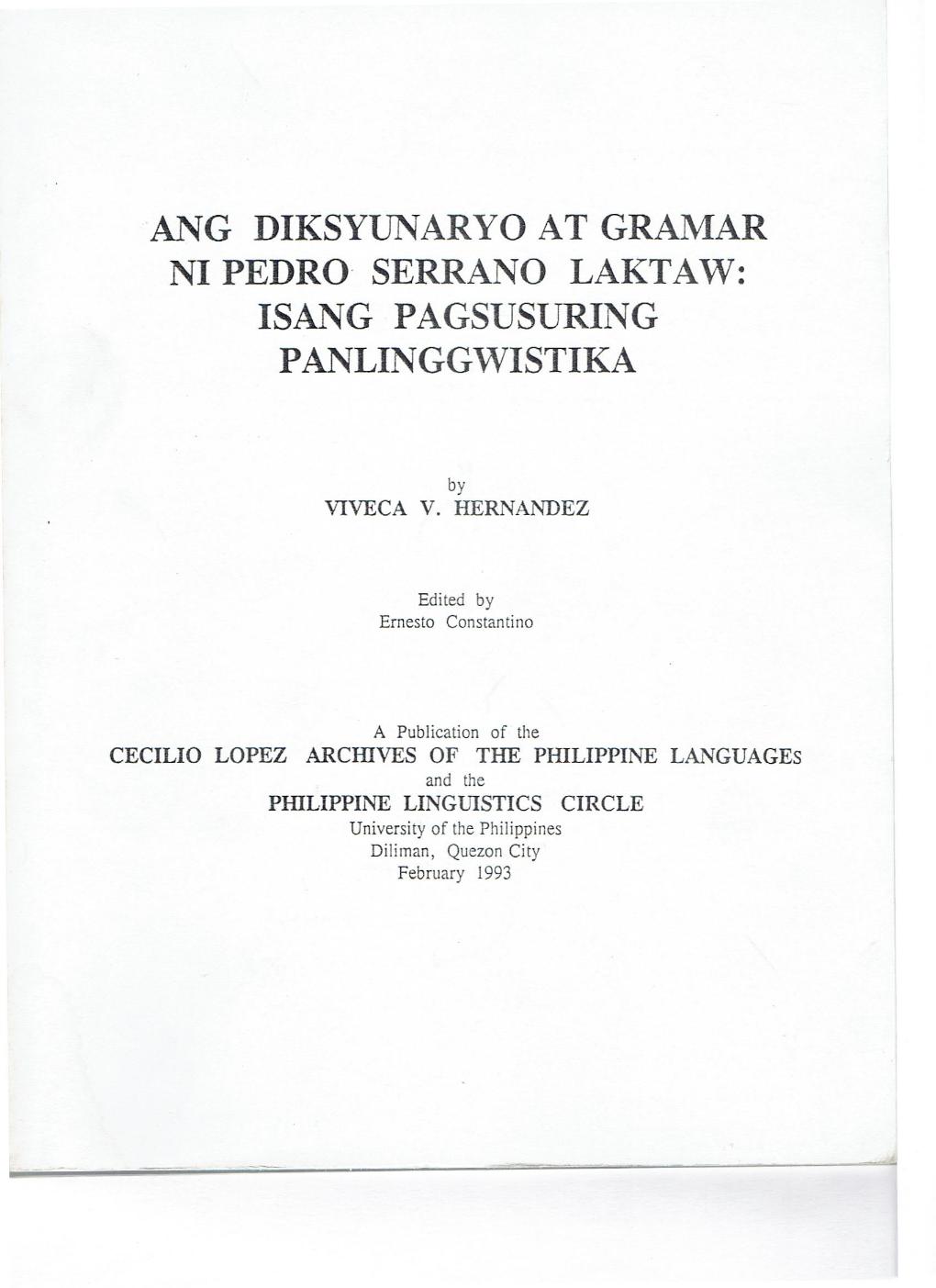 Publication Nine: Ang Diksyunaryo at Gramar ni Pedro Serrano Laktaw: Isang Pagsusuring Panlinggwistika
Vol 9 (1993)
Publication Nine: Ang Diksyunaryo at Gramar ni Pedro Serrano Laktaw: Isang Pagsusuring Panlinggwistika
Vol 9 (1993)Ang pag-aaral na ito ay isang pagsusuri ng mga pangunahing linggwistik na akda ni Pedro Serrano Laktaw. Kilala si Serrano Laktaw bilang isa sa mga naunang Pilipinong naglimbag ng sistematik at komprehensib na disksyunaryo at gramar ng wikang Tagalog. Tinutukoy dito ang tatlong akdang pinamagatang: Diccionario hispano-tagálog, primera parte (1889), Diccionario tagálog-hispano, segunda parte (1914), at Estudios gramaticales sobre la lengua tagálog (1929). Ang una at pangalawang akda ay muling nilimbag sa paksimili noong 1965 ng Ediciones Cultura Hispánica. Ang naturang edisyong paksimili at ang orihinal na edisyon ng gramar ang ginamit sa pagsusuring ito.
Maliban sa ilang manaka-nakang pagbanggit sa pangalan ni Serrano Laktaw sa kaniyang mga akda sa konteksto ng kasaysayan ng pag-aaral ng mga wika sa Pilipinas, wala pang nagagawang pagsusuri tungkol sa awtor at sa mga akda niya hanggang sa kasalukuyan.
-
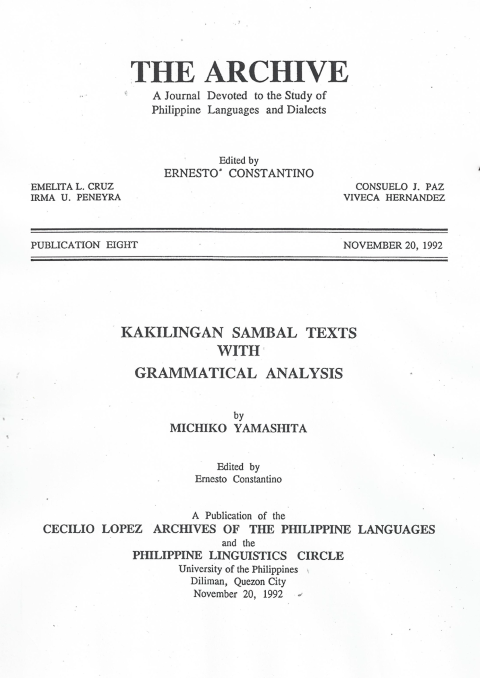 Publication Eight: Kakilingan Sambal Texts with Grammatical Analysis
Vol 8 (1992)
Publication Eight: Kakilingan Sambal Texts with Grammatical Analysis
Vol 8 (1992)This thesis presents a comprehensive description of the basic phonological and syntactic structures of a dialect of the Sambal language which is spoken in the sitio of Kakilingan, barrio Sta. Fe, municipality of San Marcelino, province of Zambales. The term “Kakilingan Sambal” is used to refer to this dialect which is also used in the neighboring areas of Kakilingan…
… Linguistically, Kakilingan Sambal is very close to Botolan Sambal. The differences between these two dialects consist mainly of some phonological features and a few lexical items. Other known dialects of Sambal are Iba Sambal, Sta. Cruz Sambal and Bolinao. None of these dialects is as close to Kakilingan Sambal as Botolan Sambal is.
The analysis of Kakilingan Sambal presented in this thesis is based on texts consisting of 21 stories told to me by Aytas between April 1977 and April 1979 in Kakilingan. I recorded the stories on a taperecorder and transcribed and translated them with the help of an Ayta girl who knew, besides her native dialect, Tagalog and Ilokano. I compared the language used in the texts with the language the Aytas used in ordinary conversation and did not find any difference between the two. Thus, in the thesis, whenever I needed forms which are not supplied by the texts, I did not hesitate to elicit them directly from informants.
-
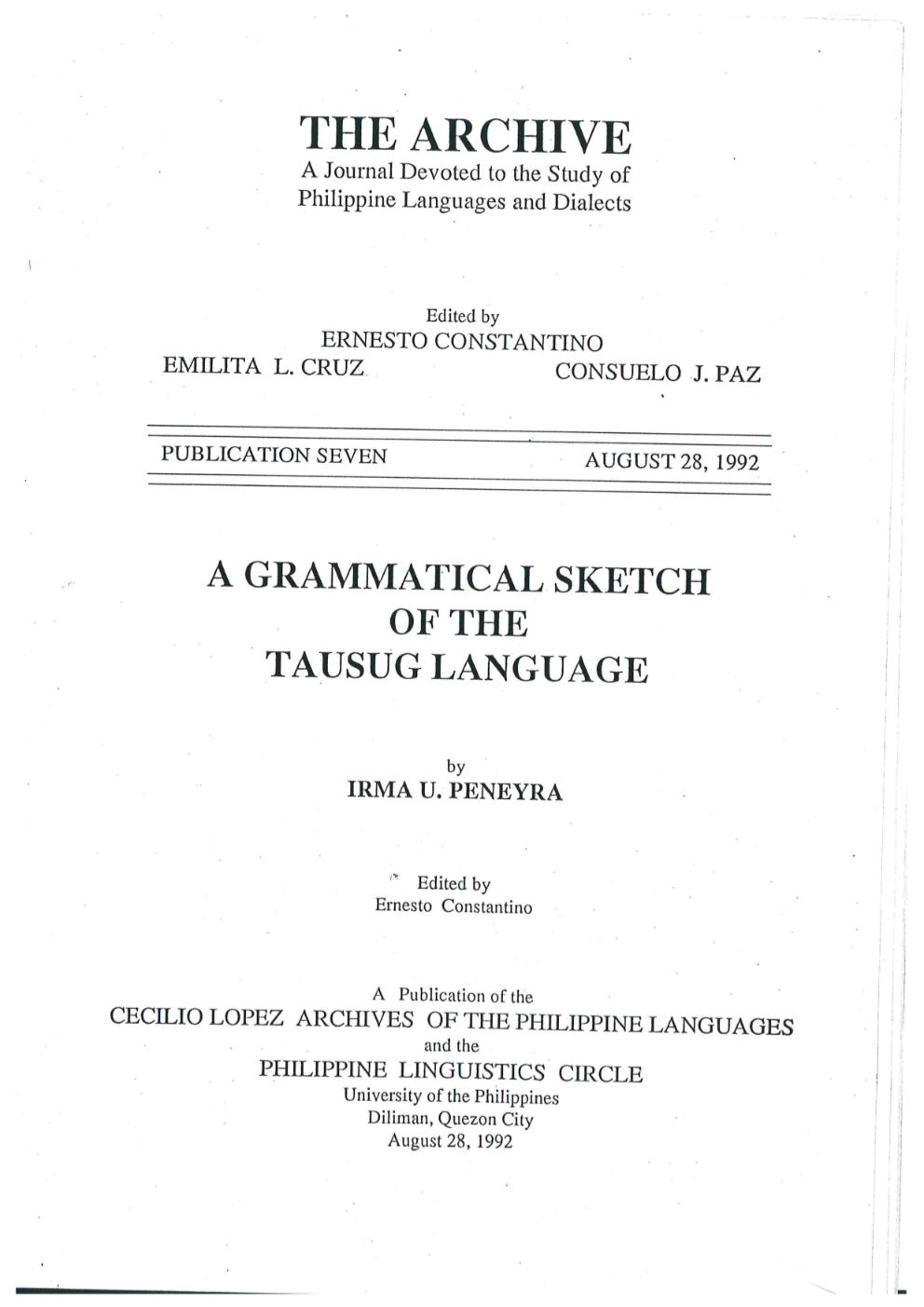 Publication Seven: A Grammatical Sketch of the Tausug Language
Vol 7 (1992)
Publication Seven: A Grammatical Sketch of the Tausug Language
Vol 7 (1992)The Tausug language (or Bahasa Sug) is the native language of the Tausug (=tau 'person' + su:g '(sea) current') who are found mostly in the province of Sulu, Philippines. Many native speakers of the language are also found in other places in the country, especially in the neighboring provinces of Tawi-Tawi, Basilan, Zamboanga del Norte, Zamboanga del Sur, and Palawan. The Tausug language functions as the principal lingua franca in Sulu, Tawi-Tawi, Basilan and in the southern part of Palawan. The 1975 Census of the Philippines reports 329,940 of the total population of the country as the number of the native speakers of Tausug.
This grammatical sketch of Tausug was submitted in 1972 to the Department of Linguistics and Asian Languages (now Department of Linguistics) by Professor Irma U. Peneyra (the present Chairman of the Department) as her thesis for the Master of Arts degree in Linguistics. As far as we know, this study presents the first comprehensive grammar of the Tausug language. Therefore, on the occasion of the seventieth anniversary of our department which was established in 1922, we are happy to make this very significant grammatical study of a very important Philippine language available to the public.
-
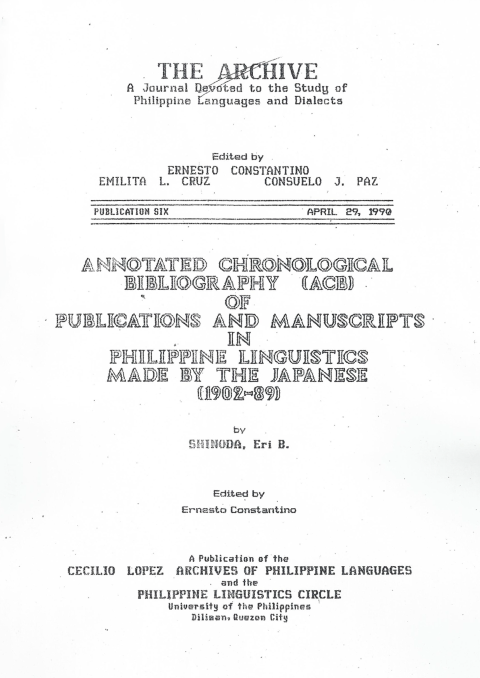 Publication Six: Annotated Chronological Bibliography (ACB) of Publications and Manuscripts in Philippine Linguistics Made by the Japanese
Vol 6 (1990)
Publication Six: Annotated Chronological Bibliography (ACB) of Publications and Manuscripts in Philippine Linguistics Made by the Japanese
Vol 6 (1990)This 215-entry Bibliography aims at efficiently serving as a research and orientation tool for those who wish to familiarize themselves with the literature on the Philippine linguistics and languages contributed by the Japanese (cf. 2.4. Nationalities of the writers), and succinctly providing them with a reference source which summarizes the accumulated body of information and lists the names of contributors, the titles of their works, and the directions and progress of their researches and analyses in this particular field, from 1902 until the end of September ‘89 (cf. 1.6. For the additional entries after October ‘89)…
… The geographical boundaries of the present Bibliography coincide with the spatial limits of the Republic of the Philippines. The sole exception, however, is Yami – one of the six Batanic (or Bashiic, or Vasayic) languages spoken on the small island called Lanyu (or Orchid Island, or Botel Topago in pre-War days) lying between Taiwan and Luzon, which politically belongs, not to the Philippines, but to Taiwan (cf. TSUCHIDA et al. (1989) (008); MORIGUCHI (1989b) (212) ). Yami has about two thousand native speakers on the island.
-
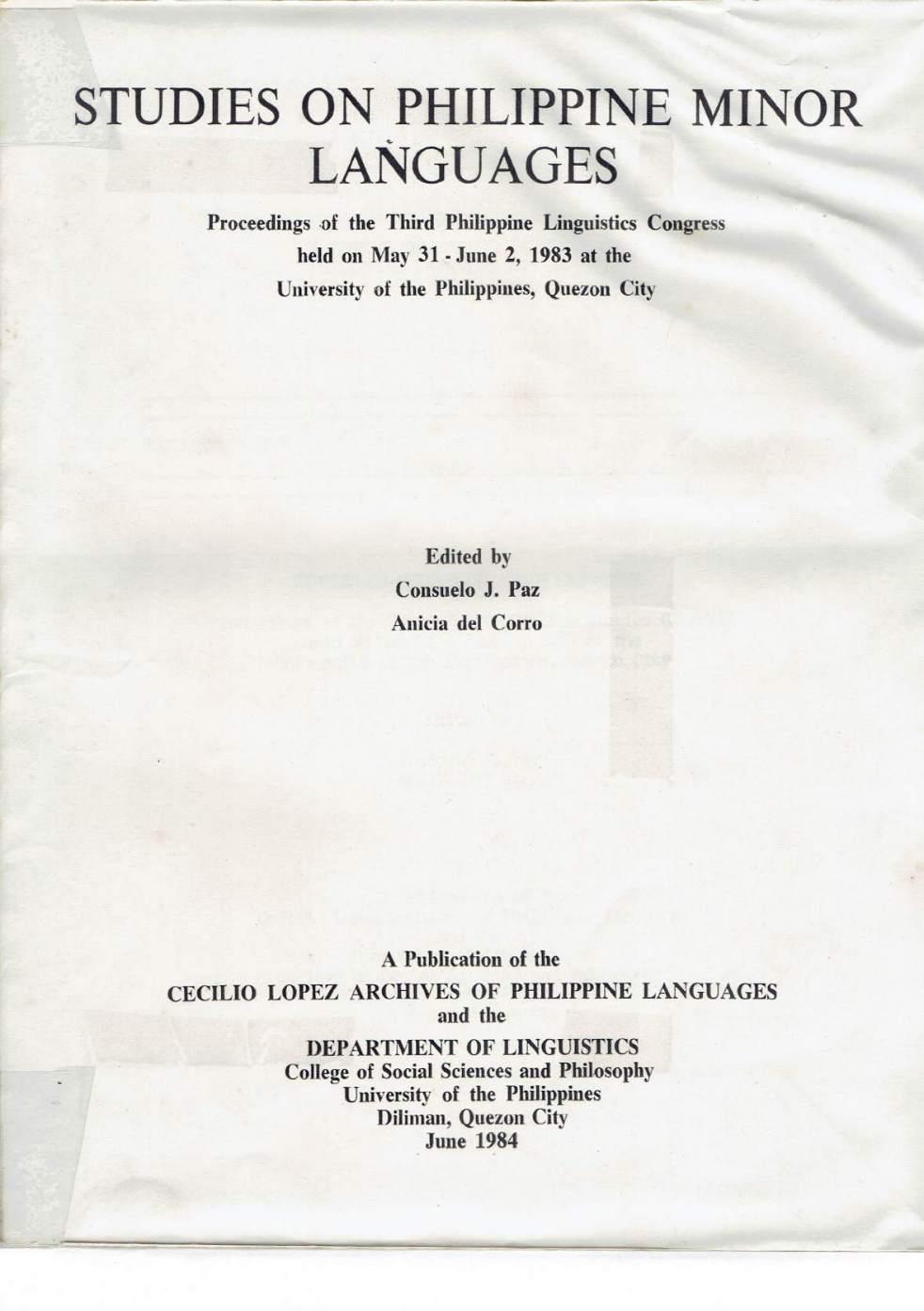 Publication Four: Studies on Philippine Minor Languages
Vol 4 (1984)
Publication Four: Studies on Philippine Minor Languages
Vol 4 (1984)This volume contains the proceedings of the Third Philippine Linguistics Congress held on 31 May to 2 June 1983 at the University of the Philippines, Quezon City. The proceedings were edited by Consuelo J. Paz and Anicia del Corro.
More than 80% of the Philippine languages are considered minor. What are the criteria to consider them as such? What is the nature of the studies that have been done on them? Are these languages considered at all in language planning for the nation?
These are some of the questions that this volume intends to answer, and in so doing, focus attention on Philippine minor languages, an aspect in Philippine linguistics which Philippine linguists have often neglected.
The articles are arranged from the general to the more specific in scope, geographically moving from the north to the southern part of the Philippines.
-
 Publication Four: A Comparative Dictionary of Tagalog
Vol 4 (1981)
Publication Four: A Comparative Dictionary of Tagalog
Vol 4 (1981)The reason for the present article on the Tagalog language is this. Mr. Fabera, a private tutor of the young Count Wrbna showed me in April 17999 in the Imperial Court Library a Spanish-Tagalog dictionary in manuscript form; it is in quarto and two inches thick. In this manuscript are entered at the end Adverbios de lengua Tagala on 5 pages. He asked me what the Tagalog language was. I could not answer his question at once and admitted that I did not know it and had never read or heard anything about it. After that time I found by chance Tagalog also mentioned in P. Sim. Pallas comparative dictionary of 200 languages spoken in Europe and Asia, published in St. Petersburg in 1787 and 1789, in quarto, and I also read in Joh. Chrph. Gatterer’s Outline of Diplomacy, Gottingen 1789, large 8o, p. 41, Tagalog writing: popular writing in the Philippine Islands. Mr. Fabrera had the kindness to lend me in February 1800 for a short time his Spanish-Tagalog dictionary which is the property of the library of Count Wrbna, and I have compared the Tagalog words which Pallas quotes with the words of other Asian languages, for example those of Malay, Magindanao, Pampango, and so on.
-
 Publication Three: A Reconstruction of Proto-Philippine Phonemes and Morphemes
Vol 3 (1981)
Publication Three: A Reconstruction of Proto-Philippine Phonemes and Morphemes
Vol 3 (1981)The objective of this study is the reconstruction of Proto-Philippine phonemes and morphemes using the comparative method. In undertaking this task, I hope to verify the relationship that holds between the languages found in the Philippines, and to test the workability of the comparative method for the Philippine languages which have no historical texts earlier than the 16th century. The specific results of this study are the reconstruction of the Proto-Philippine phonemes and a dictionary of proto-phonemes.
This study therefore deals with the phonologic system and part of the lexicon of the posited Proto-Philippine language. As Hoenigswald (1950: 357) says, attempting to reconstruct the earlier language by means of the comparative method is “essentially a problem in phonemics.” The establishment of the sound system of the posited parent language is generally given precedence over its other systems1 since the evidence for it is more readily systematized and more readily fulfills the principle of total accountability. Reconstructing the other systems of the earlier language would mean a much more comprehensive work entailing more time and diverse data which I am not in a position to deal with at present. Thus, morphologic and syntactic comparison and reconstruction will have to be treated in a sequel to this present study. The semantic system likewise deserves a separate treatment.
-
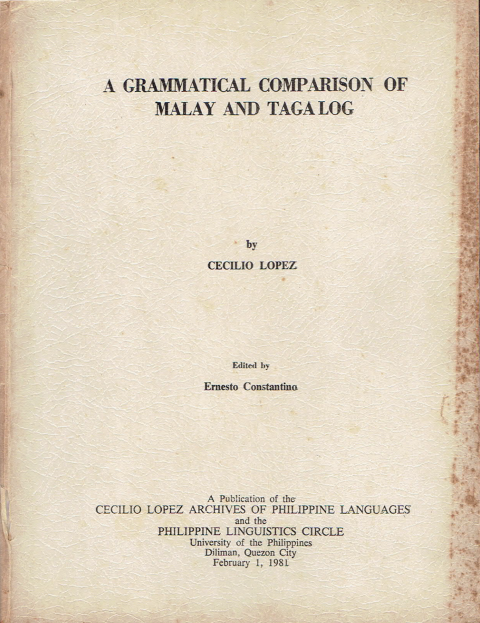 Publication Two: A Grammatical Comparison of Malay and Tagalog
Vol 2 (1981)
Publication Two: A Grammatical Comparison of Malay and Tagalog
Vol 2 (1981)It is perhaps superfluous to repeat here what is already known even to the layman, that Malay and Tagalog have many items in common in their vocabularies. What is likely not generally known, however, is that while there are some features in grammar which the two languages share, there are many more in which they differ. My purpose in making this comparison is to show the average speaker of Malay and Tagalog how each other’s language looks like. To be sure, their cultures had been under foreign influences for centuries, again a well-known fact, and these influences had bestowed a largess in the languages of the former wards, particularly in their vocabularies: the Malays predominantly under British, Dutch and Islam, the Tagalogs under Spanish, American and Christian influences.
-
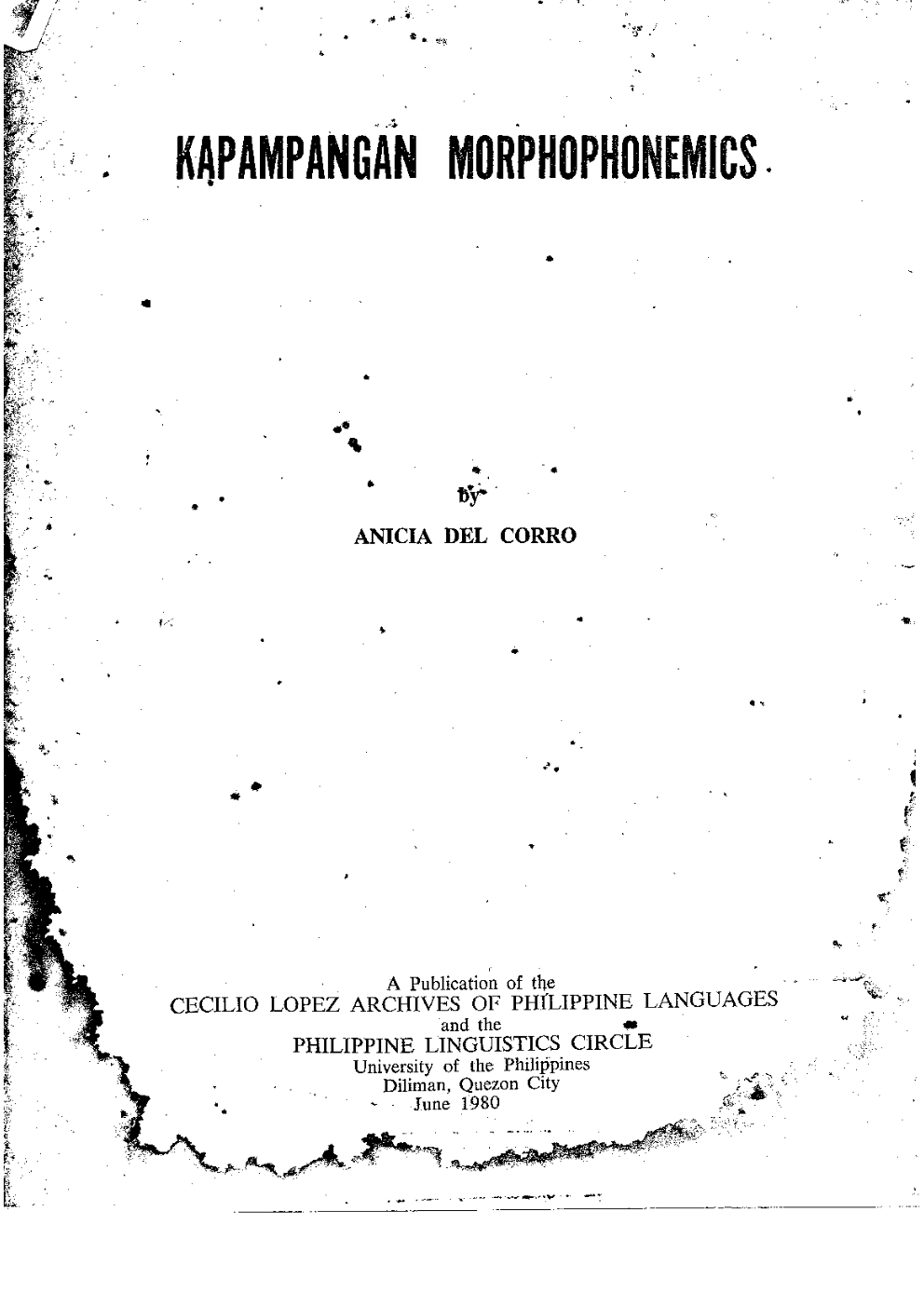 Publication One: Kapampangan Morphophonemics
Vol 1 (1980)
Publication One: Kapampangan Morphophonemics
Vol 1 (1980)Kapampangan is one of the eight major languages of the Philippines. It has about 900,000 native speakers residing in all the towns of the province of Pampanga, including the city of Angeles; in four towns of Tarlac, namely, Bamban, Concepcion, Tarlac and Capas; in the town of Cabiao in Nueva Ecija; and in two towns of Bataan, namely, Dinalupihan and Hermosa.
This is an attempt to study the morphophonemic system of Kapampangan. It aims to capture the linguistically significant generalizations about morphophonemic changes and processes in the language. The first three chapters deal with the phonology and phonological processes of the language. The fourth chapter identifies, clarifies and describes the phonologically conditioned morphophonemic rules that specify the phonemic shapes of the inflectional forms of the verbs. Explanations for the different changes are descriptive rather than historical. Whenever necessary and helpful, the historical explanation of some morphological forms is added in the footnote.
-
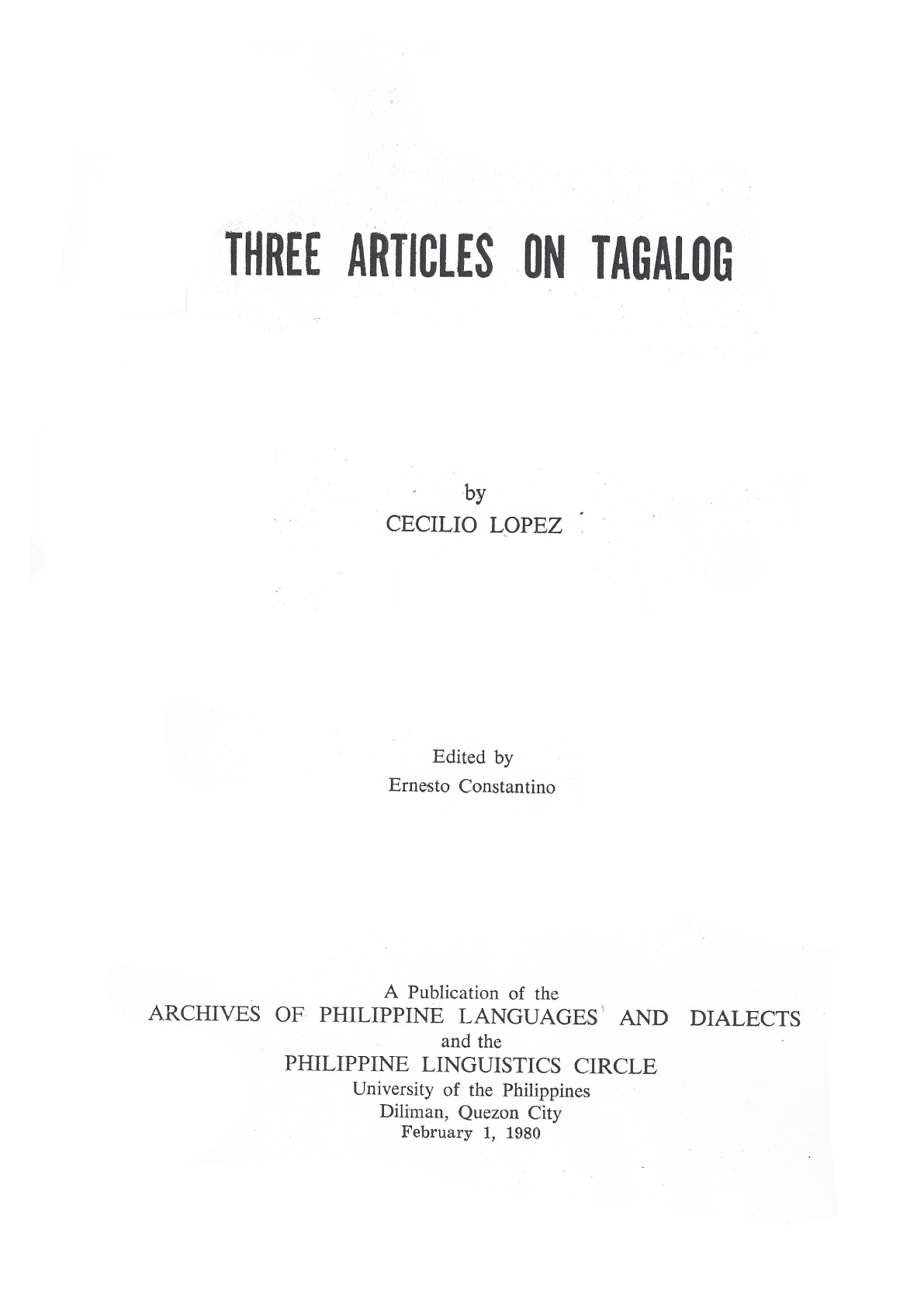 Special Monograph Issue No. 7: Three Articles on Tagalog
Vol 7 (1980)
Special Monograph Issue No. 7: Three Articles on Tagalog
Vol 7 (1980)When Dr. Cecilio Lopez, the first Filipino scientific linguist, died unexpectedly on September 5, 1979 at the age of eighty-one years and seven months, he left behind several manuscripts. Among these manuscripts are a 500-page comparison of Tagalog and Malay, and three articles on Tagalog. The three articles are published posthumously in this special issue of The Archive.
The first of the three articles of Dr. Lopez in this issue is a short but comprehensive grammar of Tagalog. It is essentially a condensed and updated version of his A Manual of the Philippine National Language (1941). The last two articles are historical studies dealing with some “new” or “unreported” morphemes in Tagalog. The three articles appear here as Dr. Lopez left them with only a few minor changes.
